Organization
Each GE or GEP was organized as a combat group (platoon-sized), consisting of an officer (commander of group), a sergeant (assistant) and 28 soldiers, organized into 3 sections, each consisting of two squads. Section leaders usually held the rank of corporal. The commander and sergeant from each group were typically military or former military personnel. The remaining fighters were local Africans. Usually four GEs or GEPs formed a company. A company headquarters element had the co-located assistance of two Alouette II helicopters loaned from the Portuguese Air Force or the Police, for transporting, medevac, target location and close air support during individual platoon or even section operations. A company would usually be led by a Portuguese major of the infantry or artillery with a captain as second-in-command, assisted by three lieutenants, four sergeant majors and eight sergeants looking after intelligence, operations, training and logistics, and cover an area of 100 square kilometres and population of 50,000. A platoon had two rifle sections armed with FN FAL and one 'heavy' section armed with 2 two-inch mortars and two M67 recoilless rifles. The two rifle sections each also had one FN MAG operator with another Rifleman carrying spare ammunition and barrels; and one Rifleman with a Rifle Grenade enabled FN FAL carrying three ENERGA anti-tank rifle grenades in the rifle grenade role. The heavy section was armed with FBP submachine guns with one lone rifleman armed with an FN FAL. From 1973 onwards, many of the heavy sections tended to discard their extra M67 recoilless rifle in favour of a single M2 Browning Heavy Machine Gun, mounted on a jeep. Each Platoon was armed with two AN/MPQ-4 counter mortar Radars, with which the platoon leader could track the location of enemy mortars and call in artillery and air support. The headquarters platoon of the company also had a heavy section used a flying firefighting squad for all platoons, armed with 2 M2 Browning HMGs and 1 mounted on two jeeps and a single M40 recoilless rifle on a jeep, commanded by a sergeant. The heavy section could be deployed into operation by helicopters.
While the GEP were all grouped together under a single parent unit the Batalhão de Grupos Especiais Páraquedistas (Battalion of Special Groups Paratroopers), the GE were dispersed, operating under the command of several regular Army units and employed as their intervention sub-units.
The FN FAL is a battle rifle designed in Belgium in 1953 by Dieudonné Saive and manufactured by FN Herstal.
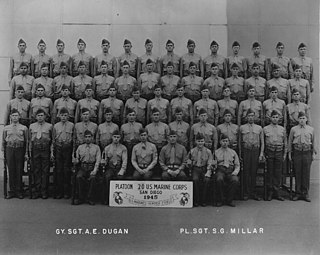
A platoon is a military unit typically composed of two to four squads, sections, or patrols. Platoon organization varies depending on the country and the branch, but a platoon can be composed of 20–50 troops, although specific platoons may range from 10 to 100 people. A platoon is typically the smallest military unit led by a commissioned officer. The platoon leader is usually a junior officer—a second or first lieutenant or an equivalent rank. The officer is usually assisted by a platoon sergeant.
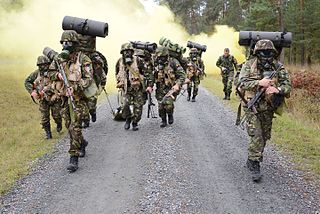
In military terminology, a squad is among the smallest of military organizations and is led by a non-commissioned officer. NATO and U.S. doctrine define a squad as an organization "larger than a team, but smaller than a section." while U.S. Army doctrine further defines a squad as a "small military unit typically containing two or more fire teams." In American usage, a squad consists of eight to fourteen soldiers, and may be further subdivided into fireteams.
Heavy weapons platoon (HWP) is a term from military science which refers to an infantry platoon equipped with machine guns, mortars, rocket-propelled grenades, flamethrowers, grenade launchers, anti-tank weapons, or any other weapons that are portable but heavier than a single infantryman can reasonably transport and operate by themselves for combat, generally a crew-served weapon. Heavy weapons platoons are grouped into a weapons company or maneuver support company, which focuses on moving and using heavy weapons to support light infantry rifle companies armed with standard-issue small arms.

A section is a military sub-subunit. It usually consists of between 6 and 20 personnel. NATO and U.S. doctrine define a section as an organization "larger than a squad, but smaller than a platoon." As such, two or more sections usually make up an army platoon or an air force flight.
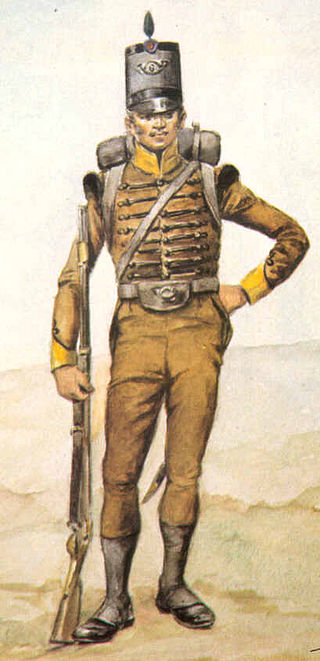
Light infantry refers to certain types of lightly-equipped infantry throughout history. They have a more mobile or fluid function than other types of infantry, such as heavy infantry or line infantry. Historically, light infantry often fought as scouts, raiders, and skirmishers. These are loose formations that fight ahead of the main army to harass, delay, disrupt supply lines, engage the enemy's own skirmishing forces, and generally "soften up" an enemy before the main battle. Light infantrymen were also often responsible for screening the main body of a military formation.
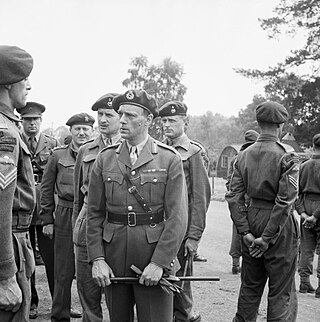
The green beret was the official headdress of the British Commandos, a special-forces unit active during World War II. It is still worn by members of the Royal Marines after passing the Commando Course, and personnel from other units of the Royal Navy, Army and RAF who serve within 3 Commando Brigade and who have passed the All Arms Commando Course.

The 1st Battalion, Rhodesian Light Infantry (1RLI), commonly The Rhodesian Light Infantry (RLI), was a regiment formed in 1961 at Brady Barracks as a light infantry unit within the army of the Federation of Rhodesia and Nyasaland. Barely a year after its creation, it was relocated to Cranborne Barracks (Salisbury) where its headquarters remained for the rest of its existence. The Regiment became part of the Southern Rhodesian Army when the Federation dissolved at the start of 1964 and, later that year, reformed into a commando battalion.

The CTOE - Centro de Tropas de Operações Especiais, based in Lamego, is a unit of the Portuguese Army with the mission of instructing troops in unconventional warfare and counter-terrorism. Until 2006, it was known as CIOE - Centro de Instrução de Operações Especiais.

The maroon beret in a military configuration has been an international symbol of airborne forces since the Second World War. It was first officially introduced by the British Army in 1942, at the direction of Major-General Frederick "Boy" Browning, commander of the British 1st Airborne Division. It was first worn by the Parachute Regiment in action in North Africa during November 1942.

The Brigada de Reacção Rápida is a unit of the Portuguese Army which was known as BAI - Brigada Aerotransportada Independente until 2006. Its different units are highly trained Paratroopers, Commandos and Special Operations Troops capable of responding to threats in any part of continental Portugal or any other Portuguese overseas territory with quick deployment by air, sea or land. This brigade is the most requested by the Portuguese Government to fulfill international assignments due to its experience and multi-role capability.
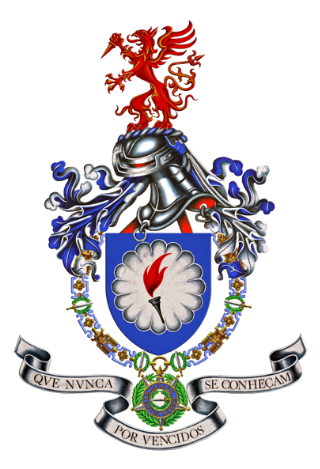
The Regimento de Paraquedistas, based in Tancos, Portugal, is a unit of the Portuguese Army and serves as the instruction center for recruitment and training of the Portuguese paratroopers. This unit includes an entire battalion, acting as support and reserve for airborne units which contains for example, military war dogs and airborne pathfinders and an instruction battalion responsible for the forming of new paratroopers.
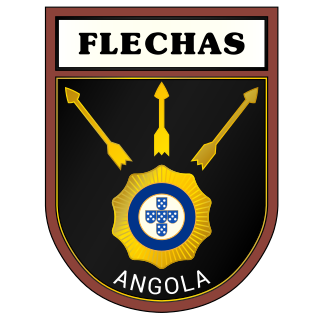
The Flechas were an elite paramilitary tactical unit of the Portuguese secret police that operated in Angola and Mozambique during the Portuguese Colonial War. Unlike most of the other Portuguese special forces that were employed in the several theatres of operations of the conflict, the Flechas were not a de jure military unit but a PIDE/DGS unit.
In various theaters of operations in the Portuguese Colonial War arose at the outset the need to create various types of irregular forces to help the Portuguese Armed Forces.

The L1A1 Self-Loading Rifle (SLR), officially "Rifle, 7.62mm, L1A1", also known by the Canadian designation C1A1 or in the US as the "inch pattern" FAL, is a British version of the Belgian FN FAL battle rifle. The L1A1 was produced under licence and has seen use in the Australian Army, Canadian Army, Indian Army, Jamaica Defence Force, Malaysian Army, New Zealand Army, Rhodesian Army, Singapore Army, and the British Armed Forces.
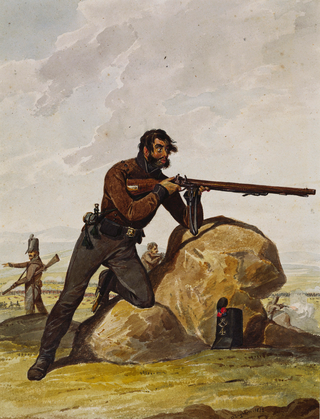
The Caçadores (hunters) were the elite light infantry troops of the Portuguese Army, in the late 18th and early 19th centuries. Units of Caçadores – with features somewhat different from the original ones – continued to exist in the Portuguese Armed Forces until the 1970s, namely the Caçadores Especiais – several special forces companies of the Portuguese Army created by the Special Operations Troops Centre at the beginning of the 1960s and heavily employed throughout the Portuguese Colonial War (1961-1974) in Africa.

Southern Rhodesia, then a self-governing colony of the United Kingdom, sent two military units to fight with the Commonwealth armed forces in the Malayan Emergency of 1948–60, which pitted the Commonwealth against the Malayan National Liberation Army (MNLA), the military arm of the Malayan Communist Party. For two years, starting in March 1951, white Southern Rhodesian volunteers made up "C" Squadron of the Special Air Service (SAS). The Rhodesian African Rifles, in which black rank-and-filers and warrant officers were led by white officers, then served in Malaya from 1956 to 1958.

The Portuguese Paratroopers are an elite infantry assault force, representing the bulk of the airborne forces of Portugal. They were created in 1956 as part of the Portuguese Air Force, being transferred to the Portuguese Army in 1993. Presently, most of the Paratroopers are part of the Portuguese Rapid Reaction Brigade which comprises all 3 special forces troops.

Fabricaciones Militares, the full name is Fabricaciones Militares Sociedad del Estado, is a state-owned Argentine arms manufacturer based in Buenos Aires. The company was a government agency under the name Dirección General de Fabricaciones Militares.















